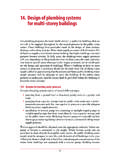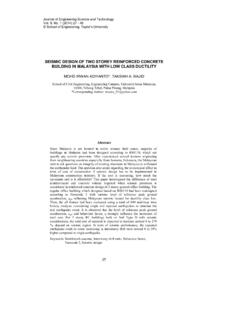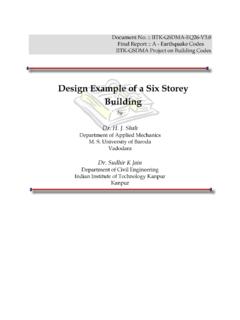Transcription of A direct approach to false discovery rates - …
1 J. R. Statist. Soc. B (2002). 64, Part 3, pp. 479 498. A direct approach to false discovery rates John D. Storey Stanford University, USA. [Received June 2001. Revised December 2001]. Summary. Multiple-hypothesis testing involves guarding against much more complicated errors than single-hypothesis testing. Whereas we typically control the type I error rate for a single-hypothesis test, a compound error rate is controlled for multiple-hypothesis tests. For example, controlling the false discovery rate FDR traditionally involves intricate sequential p-value rejection methods based on the observed data. Whereas a sequential p-value method fixes the error rate and estimates its corresponding rejection region, we propose the opposite approach we fix the rejection region and then estimate its corresponding error rate.
2 This new approach offers increased applicability, accuracy and power. We apply the methodology to both the positive false discovery rate pFDR and FDR, and provide evidence for its benefits. It is shown that pFDR is probably the quantity of interest over FDR. Also discussed is the calculation of the q-value, the pFDR analogue of the p-value, which eliminates the need to set the error rate beforehand as is traditionally done. Some simple numerical examples are presented that show that this new approach can yield an increase of over eight times in power compared with the Benjamini Hochberg FDR method. Keywords: false discovery rate; Multiple comparisons; Positive false discovery rate; p-values;. q-values; Sequential p-value methods; Simultaneous inference 1. Introduction The basic paradigm for single-hypothesis testing works as follows.
3 We wish to test a null hypothesis H0 versus an alternative H1 based on a statistic X. For a given rejection region , we reject H0 when X and we accept H0 when X . A type I error occurs when X . but H0 is really true; a type II error occurs when X but H1 is really true. To choose , the acceptable type I error is set at some level ; then all rejection regions are considered that have a type I error that is less than or equal to . The one that has the lowest type II error is chosen. Therefore, the rejection region is sought with respect to controlling the type I error. This approach has been fairly successful, and often we can find a rejection region with nearly optimal power (power = 1 type II error) while maintaining the desired -level type I error. When testing multiple hypotheses, the situation becomes much more complicated.
4 Now each test has type I and type II errors, and it becomes unclear how we should measure the overall error rate. The first measure to be suggested was the familywise error rate FWER, which is the probability of making one or more type I errors among all the hypotheses. Instead of controlling the probability of a type I error at level for each test, the overall FWER is controlled at level . None-the-less, is chosen so that FWER , and then a rejection region is found that maintains level FWER but also yields good power. We assume for simplicity that each test has the same rejection region, such as would be the case when using the p-values as the statistic. Address for correspondence: John D. Storey, Department of Statistics, Stanford University, Stanford, CA 94305, USA. E-mail: 2002 Royal Statistical Society 1369 7412/02/64479.
5 480 J. D. Storey In pioneering work, Benjamini and Hochberg (1995) introduced a multiple-hypothesis testing error measure called the false discovery rate FDR. This quantity is the expected proportion of false positive findings among all the rejected hypotheses. In many situations, FWER is much too strict, especially when the number of tests is large. Therefore, FDR is a more liberal, yet more powerful, quantity to control. In Storey (2001), we introduced the positive false discovery rate pFDR. This is a modified, but arguably more appropriate, error measure to use. Benjamini and Hochberg (1995) provided a sequential p-value method to control FDR. This is really what an FDR controlling p-value method accomplishes: using the observed data, it estimates the rejection region so that on average FDR for some prechosen.
6 The product of a sequential p-value method is an estimate k that tells us to reject ; ;: : :; , where : : : are the ordered observed p-values. What can we say about k? Is there any natural way to provide an error measure on this random variable? It is a false sense of security in multiple-hypothesis testing to think that we have a 100%. guaranteed upper bound on the error. The reality is that this process involves estimation. The more variable the estimate of k is, the worse the procedure will work in practice. Therefore, the expected value may be that FDR , but we do not know how reliable the methods are case by case. If point estimation only involved finding unbiased estimators, then the field would not be so successful. Therefore, the reliability of k case by case does matter even though it has not been explored.
7 Another weakness of the current approach to false discovery rates is that the error rate is controlled for all values of m0 (the number of true null hypotheses) simultaneously without us- ing any information in the data about m0 . Surely there is information about m0 in the observed p-values. In our proposed method, we use this information, which yields a less stringent pro- cedure and more power, while maintaining strong control. Often, the power of the multiple- hypothesis testing method decreases with increasing m. This should not be so, especially when the tests are independent. The larger m, the more information we have about m0 , and this should be used. In this paper, we propose a new approach to false discovery rates . We attempt to use more traditional and straightforward statistical ideas to control pFDR and FDR.
8 Instead of fixing . and then estimating k ( estimating the rejection region), we fix the rejection region and then estimate . Fixing the rejection region may seem counter-intuitive in the context of traditional multiple-hypothesis testing. We argue in the next section that it can make sense in the context of false discovery rates . A natural objection to our proposed approach is that it does not offer control' of FDR. Actually, control is offered in the same sense as the former approach our methodology provides a conservative bias in expectation. Moreover, since in taking this new approach we are in the more familiar point estimation situation, we can use the data to estimate m0 , obtain confidence intervals on pFDR and FDR, and gain flexibility in the definition of the error measure.
9 We show that our proposed approach is more effective, flexible and powerful. The multiple- hypothesis testing methods that we shall describe take advantage of more information in the data, and they are conceptually simpler. In Section 2, we discuss pFDR and its relationship to FDR, as well as using fixed rejection regions in multiple-hypothesis testing. In Section 3 we formulate our approach , and in Section 4 we make a heuristic comparison between the method proposed and that of Benjamini and Hochberg (1995). Section 5 provides numerical results, comparing our approach with the current one. Section 6 describes several theoretical results pertaining to the proposed approach , including a maximum likelihood estimate interpretation. Section 7 describes a quantity called the q-value, which is the pFDR analogue of the p-value, and Section 8 argues that the pFDR and the q-value are the most appropriate false discovery rate false discovery rates 481.
10 Quantities to use. Section 9 shows how to pick a tuning parameter in the estimates automatically. Section 10 is the discussion, and Appendix A provides technical comments and proofs of the theorems. 2. The positive false discovery rate and fixed rejection regions As mentioned in Section 1, two error measures are commonly used in multiple-hypothesis testing: FWER and FDR. FWER is the traditional measure used; Benjamini and Hochberg (1995) recently introduced FDR. Table 1 summarizes the various outcomes that occur when testing m hypotheses. V is the number of type I errors (or false positive results). Therefore, FWER is defined to be 1/. Controlling this quantity offers a very strict error measure. In general, as the number of tests increases, the power decreases when controlling FWER.





